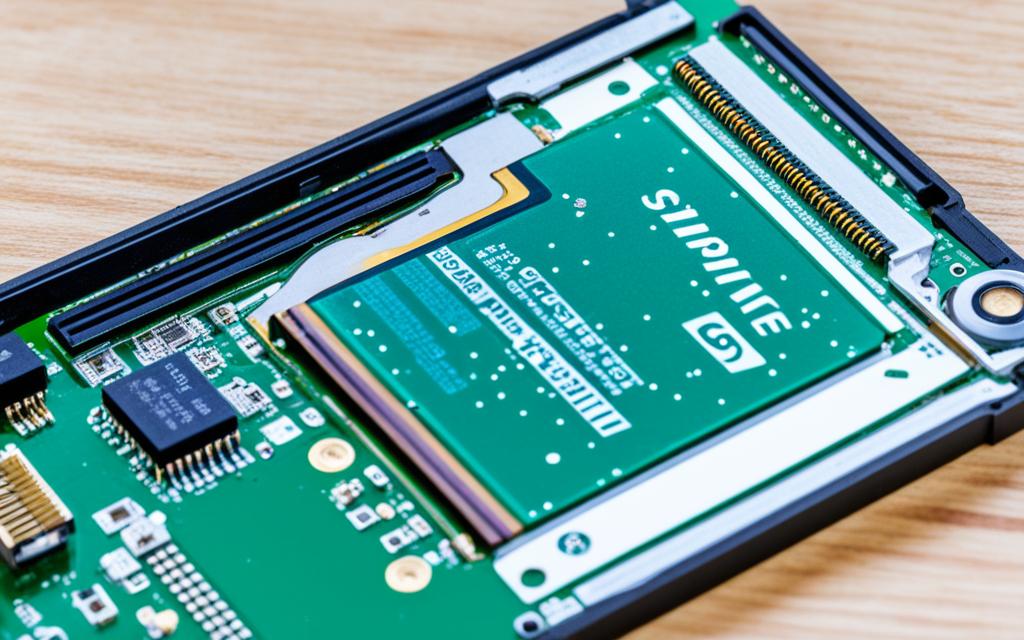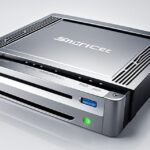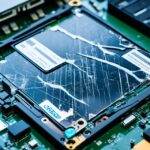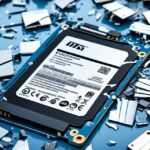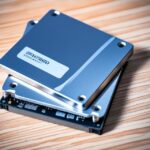Table of Contents
In our tech-savvy age, Solid State Drives (SSDs) are getting more popular. They’re faster and more reliable than old-school Hard Disk Drives (HDDs). But, like all tech, SSDs can fail. It’s important to know the signs that your SSD might be dead.
Spotting SSD failure early helps protect your data. You can then act quickly to try and recover this data. This guide will show you what to watch out for. Look for system freezes, sudden shut downs, and if your operating system can’t find the SSD. These are key signs your SSD might be failing.
Once you know these signs, you can start figuring out the problem earlier. This means less stress for you. Plus, if you take good care of your SSD, it can last between 10 to 15 years. It depends on how much you use it and where it’s kept1. We’ll also talk about how to check if your SSD is working properly. This can help you fix problems before they get worse.
Key Takeaways
- It’s vital to notice the signs of SSD failure to save your data.
- Even though SSDs are pretty good, they’re not perfect and can break.
- If your SSD stops working, try to get the data back as soon as you can.
- If your computer starts acting weird, like freezing, it might mean there’s a problem.
- Using tools to check on your SSD’s health can help keep it running smoothly.
Understanding SSDs and Their Popularity
In recent years, solid-state drives (SSDs) have become more popular. This is because they have clear advantages over traditional hard drives (HDDs). As we need better performance and reliability in computers, it’s important to know why SSDs are key in today’s tech world.
Benefits of SSDs Over HDDs
SSDs are becoming more preferred for several reasons. They provide:
- Faster boot times and quicker application load times than HDDs, making computers faster to use2.
- They’re more resistant to damage from drops.
- And they use less power, which is good for laptops and mobile devices.
Studies show the SSD market has grown by 20% each year over the last five years2. More people are choosing SSDs because they make computers faster and more efficient. This is especially true in settings where speed matters a lot.
Why SSDs are Essential for Modern Computers
Today’s software needs more from computers, highlighting the importance of SSDs. Typically, an SSD can last between 10 and 15 years. This gives users a dependable way to store their information1. However, about 70% of SSD failures can result in total data loss if not regularly backed up2.
Moving from HDD to SSD isn’t just a trend. It’s an answer to the needs of those who understand tech and businesses. Adopting SSD technology means faster and more reliable computing. It’s a step towards a better and more efficient digital future.
Signs That Indicate a Failing SSD
Knowing the symptoms of SSD failure helps keep your data safe. Spotting problems early saves important files and avoids bigger issues. Users often see signs like system freezes, strange BIOS detection, and startup errors. It’s key to back up data early to avoid loss from SSD failure. Studies show SSDs might start to fail after five years, prompting a possible change3. Ignoring these signs can lead to unreadable files, system repairs, or read-only drives4.
Common Symptoms of SSD Failure
Watch out for frequent freezes, sudden shutdowns, and your computer not recognising the SSD5. These are early warnings. Crashes at startup or many error messages mean you should pay attention. Data recovery pros suggest avoiding power spikes and not overfilling your SSD to keep it running well5.
Using SMART Tools to Monitor Health
Using SMART tools can help you keep an eye on your SSD’s health. This system comes with macOS and tracks how your SSD is doing. Windows users might need extra software for this. Watching the health, temperature, and performance alerts you to problems early4. Seeing worrisome SMART details means you should act fast. Running diagnostics or using recovery software like Stellar Data Recovery is smart.
How to Tell If an SSD is Dead
Finding out if an SSD is dead involves a few key steps. Start by looking at the BIOS. See if the SSD shows up in the BIOS menu after you start the computer. If it’s not there, the SSD might be in serious trouble. This step is essential for checking the SSD’s connection and function. It’s vital to make sure all cables are properly connected. Also, try using different SATA ports or cables if needed.
Check BIOS and Connectivity
To further troubleshoot, check the SSD’s status through the BIOS and use external tests. If BIOS recognises the SSD but problems persist, try it in a different computer. This can tell you whether the issue is with the computer or the SSD itself. Issues like boot failures or the system not recognising the drive are big red flags. Symptoms like data issues or blue screen errors often point to an SSD failure.
Boot Issues and Operating System Access
Boot problems are common with faulty SSDs. If your system can’t load or gets stuck, check the SSD’s functionality. Test for read/write errors and watch for error messages or crashes. Using software to check SSD health may help fix issues. Not being able to access data or frequent access failures often means the SSD is failing. This helps users decide on fixing it or seeking professional help, as discussed here67.
Steps to Diagnose a Potentially Dead SSD
When you think your SSD might be dead, it’s important to act carefully. First, check if it connects properly and update any needed firmware. These steps can help fix common problems or point out more serious ones. Here’s what you can do to check your SSD’s health.
External Connectivity Tests
Start with checking the SSD’s connection to another device. Use a SATA to USB adaptor or other ways to connect it. Make sure the device recognises the SSD. If you can see the SSD but it won’t work properly, this could mean there’s internal damage or the data is corrupt. How well you do these tests can really affect the outcome.
Updating Firmware and Drivers
Next, see if there are updates for your SSD’s firmware. Keeping the firmware fresh can stop many problems before they start. It can also keep your SSD from failing unexpectedly because of firmware bugs. If you’re still having trouble after the connection tests, look for firmware and driver updates. Updating them can make your SSD work better and last longer.
| Test | Description | Outcome |
|---|---|---|
| External Connection | Connect SSD using SATA to USB or similar method | Determines if SSD is recognised by system |
| Data Transfer | Attempt to read/write files on SSD | Identifies potential data corruption or internal failures |
| Firmware Update | Check for available updates from manufacturer | Can resolve performance issues and prevent failures |
By following these steps, you can figure out what’s going on with your SSD. It helps avoid data loss and keeps your SSD working well. This careful approach helps tackle problems early. It shows why it’s good to check your SSD regularly and keep its software up to date893.
Common Causes of SSD Failure
Understanding what leads to SSD failure is key to protect your data and ensure it works well. Issues range from physical harm to firmware complexities. By knowing these risks, you can take steps to keep your SSD in good shape and avoid sudden troubles.
Physical Damage and Shock Risks
Physical damage tops the list of SSD killers. Drops or harsh environments can badly affect them. It’s crucial to handle your SSD carefully and watch its environment. This helps avoid damage. Manufacturers point out that extreme temperatures are a big problem. They can lead to overheating, which may reduce performance or cause data loss10.
Overheating and Its Consequences
SSD overheating is a big issue too. It can stop the SSD from working properly. High temperatures mean parts might start to fail. Research underlines the seriousness of overheating. It leads to many SSDs failing. To prevent this, make sure your SSD stays cool. This keeps it working longer and more reliably10.
Firmware Problems and Their Impact
Firmware troubles pose a big risk to SSDs. If firmware is old or broken, the SSD might not work well and could stop working. Regular firmware updates are critical. They keep the SSD working right and fix problems11. Dealing with these issues quickly helps prevent data loss and keeps your SSD running smoothly.
FAQ
How can I tell if my SSD is dead?
To check an SSD’s status, try connecting it to a different computer. If it’s not recognised, it might be dead. Issues like constant boot problems and the operating system not loading are big signs. Checking the BIOS is also a good step.
What are the common signs of SSD failure?
If your system often freezes unexpectedly, it might be a sign. Also, if boot-up is hard and the BIOS doesn’t see the SSD. If anything odd happens, backup your data straight away.
Is it possible to recover data from a dead SSD?
Recovering data from a dead SSD could work. If there’s no physical damage and you’re quick, seeking professional help is a good idea. To raise your recovery chances, don’t use the SSD further.
Why are SSDs preferred over traditional HDDs?
SSDs bring many benefits over HDDs. They allow for quicker data access and lower the time to start apps and boot. With no moving parts, they’re more durable and use less power. These advantages make SSDs vital for modern computers.
How can I monitor the health of my SSD?
Monitoring an SSD’s health is crucial. SMART tools help with this task. These tools come built into macOS, but Windows users might need extra software. They help you track performance and spot possible failures early.
What are the major causes of SSD failure?
SSDs can fail if they’re dropped or get too hot from bad ventilation. Out-of-date or broken software can also cause problems. Knowing these risks helps you avoid them.
How can I diagnose a potentially dead SSD?
Start by connecting the SSD to another device to see if it works. If it doesn’t respond, look for software updates. Sometimes, older software is the problem.
What should I do if my SSD is making unusual noises?
SSDs don’t make noise because they lack moving parts. Hearing strange sounds could mean issues with other computer parts. If your SSD seems faulty, act quickly to save your data.
Source Links
- https://www.diskinternals.com/partition-recovery/how-to-know-ssd-dead/ – Is my SSD dead?
- https://www.diskmfr.com/ssd-troubleshooting-how-to-know-if-your-ssd-is-dead/ – SSD Troubleshooting: How to Know If Your SSD Is Dead
- https://www.makeuseof.com/tag/5-warning-signs-ssd-break-fail/ – 5 Warning Signs Your SSD Is About to Break Down and Fail
- https://www.stellarinfo.com/blog/how-to-deal-with-warning-signs-of-a-dying-ssd/ – How to Deal With Warning Signs of a Dying SSD?
- https://techchefmadhuri.medium.com/what-happens-when-ssd-dies-1c1974ed3609 – What Happens When SSD Dies?
- https://www.minitool.com/backup-tips/how-to-tell-if-ssd-is-failing.html – How to Tell if SSD Is Failing? Check Failure Signs & What to Do?
- https://www.easeus.com/partition-manager-software/repair-and-restore-not-working-failed-dead-ssd.html – How to Repair and Restore Not Working/Failed/Dead SSD 🔥
- https://superuser.com/questions/1758806/how-to-recover-files-from-a-dead-ssd – How to recover files from a dead SSD?
- https://www.techtarget.com/searchstorage/tip/4-causes-of-SSD-failure-and-how-to-deal-with-them – 7 causes of SSD failure and how to deal with them | TechTarget
- https://www.securedatarecovery.co.uk/blog/ssd-failure – 6 Causes of SSD Failure & Their Warning Signs
- https://hdsentinel.com/blog/failing-ssd-symptoms – 8 Failing SSD Symptoms and What to Do to Save Your Data

